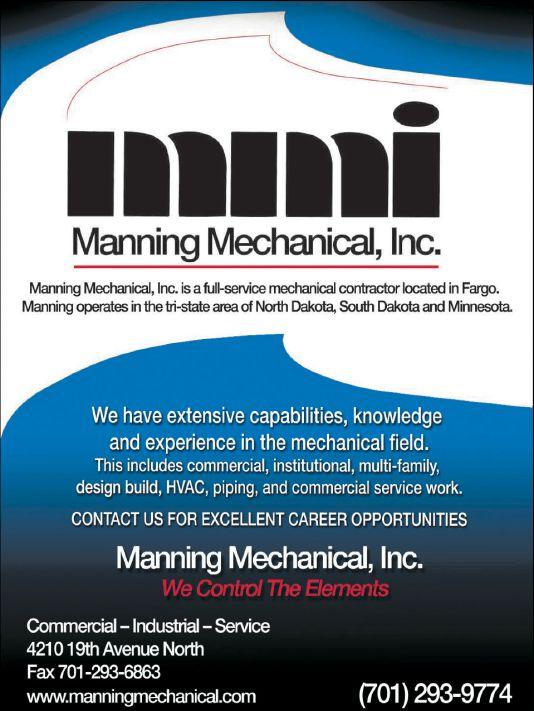
3 minute read
russ hanson
It is the pulse. This discussion is very timely. What we seem to be witnessing here in North Dakota, really, is similar to the national scene. There are AGC chapters throughout all of the 50 states, and collectively we, as executives, have been talking about this very issue - of supply chain and inflation – and how they are impacting the industry. We are all similarly impacted, and not only by the supply chain, which is an issue; but the bigger issue is the cost, the construction inflation.
Since September of 2020 through March of 2022, our national AGC economist said the inputs have increased on an average of 21.5%. That is real and when you are signing contracts and having to account for material and supplies, and having increases like that, it lends to interesting discussions with owners of whom you have bids with.
Q: Yes, pocket books only go so deep. How are companies meeting these challenges?
Invariably prices have gone up, which is reflected in the bid awards. However, while the national supply price inputs have gone up 21%, the bids have only gone up on average, nationally, about 17%. The prices have gone up and anybody, any owner, will certainly recognize that.
I think one of the things that we’ve been talking about in the industry is the owners who are bidding the projects and those that are receiving them are having conversations to take into account that it’s taking longer for some materials to arrive.
They’re taking a look at the flexibility and the completion deadlines and in the contracts and things like that, looking at all avenues to try to still complete projects while taking into account that there is some pretty severe inflation in the market.
Q: No one knows, of course, but when do you foresee the situation getting better?
I’m not certain how quickly it will ease, but I do believe it’s going to be around for a while. The fact of the matter is, we’ve got a real trucking and trucker shortage, and so when there is product, there is a limited amount of availability to get it out. I can’t see exactly how long it’s going to be around, but I think it’s going to be here for a while and certainly throughout this season.
Q: Is your industry challenged by workforce needs these days?
Like every other industry, absolutely. Everybody asks, “Where have the people gone?” Workforce is definitely a challenge; construction is not alone. That is definitely an issue and one that I think will continue to be an issue. We have an unemployment rate in North Dakota at about 3%, so there are not a lot of people available and it is very competitive for the various industries who are seeking those (potential workers) that are available.
Q: What impact does the construction industry have on North Dakota?
Construction, despite some of the images that people have of construction, is really a very good career choice and we need to do a better job as an industry of promoting that. We have a significant impact on the economy.
There’s about 27,000 construction employees that are contributing to the economy, building and repairing the infrastructure. The jobs pay well, they have benefits and retirement. They’re not minimum wage jobs. They’re very good paying jobs and there’s almost 30,000 of them that are working here in North Dakota.
Q: What do you foresee for the industry over the next couple of years? What are some bright spots?
Yes, I don’t want to come across as all doom and gloom. Congress has passed the bipartisan infrastructure bill, so there is a five-year infrastructure bill that was enacted earlier this year – it’s a five-year bill that was fully funded.
There’s some certainty for the highway and the bridge and there’s some broadband money in there for the next five years from our federal programs. So that certainly is a very good thing, a very good thing. If we can get the inflation to moderate, that would be better, because there were increased resources in that. We were very happy with that from the previous program, and so that certainly is a good thing.
Our state legislature, as our economy has done well over the past 10 years when they’ve met, has committed a significant amount of resources towards all types of infrastructure – flood protection, highways, roads and bridges, vertical commercial. During the 2021 session they passed a very large bonding bill, which allowed the state to finish its financial obligations for the Fargo Moorhead diversion and the Minot flood control projects, two very important things for two of our bigger populated areas.
The legislature over the past 10 years has literally invested bil- continued on page 35
FUL LY-IN TEGRATED FO RB ETTE RR ES ULTS
With as ha re dv is io nand th eu niqu e abilit ytoa ct asdeve lo per,contrac to r an dp roper ty ma nage r, ourteamis revo lution izin gm ultifa mily,com me rcial an dindu strials pacesacrosstheMidwest.
VI EW OP EN PO SI TI ON S& AP PLY encla ve co mp an ie s. co m/ca reers
Now hiring for a growing company








